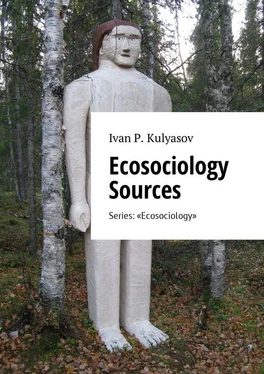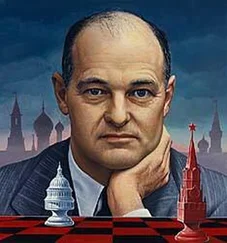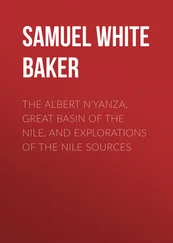I. Kulyasov - Ecosociology Sources. Series - «Ecosociology»
Здесь есть возможность читать онлайн «I. Kulyasov - Ecosociology Sources. Series - «Ecosociology»» — ознакомительный отрывок электронной книги совершенно бесплатно, а после прочтения отрывка купить полную версию. В некоторых случаях можно слушать аудио, скачать через торрент в формате fb2 и присутствует краткое содержание. ISBN: , Жанр: Прочая научная литература, на английском языке. Описание произведения, (предисловие) а так же отзывы посетителей доступны на портале библиотеки ЛибКат.
- Название:Ecosociology Sources. Series: «Ecosociology»
- Автор:
- Жанр:
- Год:неизвестен
- ISBN:9785449009913
- Рейтинг книги:5 / 5. Голосов: 1
-
Избранное:Добавить в избранное
- Отзывы:
-
Ваша оценка:
- 100
- 1
- 2
- 3
- 4
- 5
Ecosociology Sources. Series: «Ecosociology»: краткое содержание, описание и аннотация
Предлагаем к чтению аннотацию, описание, краткое содержание или предисловие (зависит от того, что написал сам автор книги «Ecosociology Sources. Series: «Ecosociology»»). Если вы не нашли необходимую информацию о книге — напишите в комментариях, мы постараемся отыскать её.
Ecosociology Sources. Series: «Ecosociology» — читать онлайн ознакомительный отрывок
Ниже представлен текст книги, разбитый по страницам. Система сохранения места последней прочитанной страницы, позволяет с удобством читать онлайн бесплатно книгу «Ecosociology Sources. Series: «Ecosociology»», без необходимости каждый раз заново искать на чём Вы остановились. Поставьте закладку, и сможете в любой момент перейти на страницу, на которой закончили чтение.
Интервал:
Закладка:
I can name another three fields of activity in the Soviet period, also aimed at ecologization, which are little known by ecosociologists. Ecosociological researchers view the Russian ecological movement as one of the main study subjects of ecosociology. However, they only attend to public organizations and some prominent environmental activists, somehow leaving aside the lines of activity listed below. I hope the situation will change in the future.
The second line of activity relates to the movement of inventors and innovators. Many suggestions made by inventors and innovators were aimed at saving and restoration of natural resources, ensuring their more efficient use and recycling, and elimination of waste toxicity. Some suggestions intended to improve the conditions of communal living, health protection, disease treatment and safety. This activity also needs to be studied in the industries associated with natural resource use – agriculture, forestry and fisheries, tourism and so on.
The third line of activity is probably the oldest, and much of it falls within the pre-Soviet period. It relates to national cultural traditions of environmental friendliness and nature conservation. These traditions are absorbed with “mother’s milk” via nurturing and education in the skills of a traditional natural resource use within the family and the local community. Methods for transmission include linguistic terms, folklore, and lifestyle. Our Russian predecessors, apart from giving birth to us, did preserve the natural wealth in its entirety for us to use.
The third line is tourism, sport, medicine, maternity and everything else associated with health and human reproductivity because, in the Soviet period, unpolluted environment was perceived as a healthy environment. Individuals and society in general have always shown great concern for nature conservation and for being able to use its healing power.
The firth is arts – poetry, painting, sculpture and music. The pre-Soviet, Soviet and post-Soviet poets, painters, sculptors and composers have made an invaluable contribution to propagation of love for nature. Their perception of nature’s beauty, power and importance indicates a special sense of beauty that complements the five senses.
However, this love for nature was somewhat ambiguous because, ideologically, the state cultivated the notion of humans as conquerors of nature on the planetary and, in the long term, on the galactic scale. As an example, scientists, engineers and politicians earnestly discussed projects, which were to divert great Siberian Rivers to the south. As a result, the Intergovernmental Conference on Environmental Education, initiated by United Nations Educational, Scientific and Cultural Organization (UNESCO) and United Nations Environment Programme (UNEP) and giving momentum for specialized training of Russian experts and lecturers, took place only in 1977 in Tbilisi. The First All-Union Conference on environmental education, held in Minsk in 1979, prepared recommendations for the ministries of education, culture, justice, nature protection societies and “nature protection squads”, thus shifting the focus of attention from love for nature to its protection.
The significance and relevance of the public environmental initiatives of the 1980s and 1990s was so high that some authors deny the existence of the ecological movement until the emergence of college-based “nature protection squads” in the early 1970s. The All-Russian Society for Nature Conservation, which began its activities in 1924, and local eco-groups are discarded as they never opposed the idea of extensive economic development. However, if we recall the structure and history of Western environmentalism described above, we will see that the nature conservation initiative is only a part of the ecological movement.
The Third All-Union Conference on Environmental Education, held in Kazan’ in 1990, formulated the task of establishing a system of continuous ecological education. The conference prepared the document titled “ Environmental program for the 13 thfive year period and until the year 2005 ”, elaborated pursuant to the USSR Supreme Soviet resolution “ On urgent measures relating to the country’s ecological recovery ” (№829—1 of 27.11.1989). It provided for introduction of universal ecological training, organization of systematic environmental education for various population categories, establishing environmental information-support centers at universities and research institutes. That marked the end of the Soviet period of the ecological movement.
A strong momentum for further development of Russian ecosociology in the 1980s was given by the Chernobyl’ accident and the increasingly frequent local ecological disasters, which intensified ecological concern and then grew into protests staged by the environmental movement with the support of the public. The greatest concern was voiced by experts who were able to draw the authority’s attention to the discovered ecological problems and risks via ecological councils, simultaneously raising public awareness through publications in the media.
The population and all other participants of the process, satisfying themselves, though direct perception of ecological problems, that the experts were right, were then trying to influence decision-makers to change the situation for the better. In this, they were hampered by the state system and social institutes. In response, they initiated a program of collective action comprising protest rallies, demonstrations, actions of resistance, protest letters, denunciatory publications and public speeches, establishing of new parties and eco-political movements. In parallel with that, another part of the environmental movement was peacefully clearing streets from garbage in spring, planting trees and flowers and teaching children to love nature. A study of the ideas, values, discourse and practices promulgated by these movements provides a good opportunity for extending the understanding of the ecosocial reality.
Конец ознакомительного фрагмента.
Текст предоставлен ООО «ЛитРес».
Прочитайте эту книгу целиком, купив полную легальную версию на ЛитРес.
Безопасно оплатить книгу можно банковской картой Visa, MasterCard, Maestro, со счета мобильного телефона, с платежного терминала, в салоне МТС или Связной, через PayPal, WebMoney, Яндекс.Деньги, QIWI Кошелек, бонусными картами или другим удобным Вам способом.
Примечания
1
Spencer H. Social statics. 1851.; The study of sociology. 1872.; Descriptive sociology. 1873—1881.
2
Schaffle A.E.F. Bau und leben des sozialen körpers. 1875—1878. (in German)
3
Worms R. De natura et methodo sociologiae. Lutetiae Parisiorum: V. Giard et E. Brière. 1896. 102 p.; Organisme et société. Paris: V. Giard et E. Brière. 1896. 412 p. (all in Latin)
4
Malthus T.R. Essay on the principle of population. 1798.
5
Darwin Ch. R. On the origin of species by means of natural selection, or the preservation of favoured races in the struggle for life. 1859.
6
Spencer H. Progress: Its law and cause. Chapman’s Westminster Review. 1857.
7
Интервал:
Закладка:
Похожие книги на «Ecosociology Sources. Series: «Ecosociology»»
Представляем Вашему вниманию похожие книги на «Ecosociology Sources. Series: «Ecosociology»» списком для выбора. Мы отобрали схожую по названию и смыслу литературу в надежде предоставить читателям больше вариантов отыскать новые, интересные, ещё непрочитанные произведения.
Обсуждение, отзывы о книге «Ecosociology Sources. Series: «Ecosociology»» и просто собственные мнения читателей. Оставьте ваши комментарии, напишите, что Вы думаете о произведении, его смысле или главных героях. Укажите что конкретно понравилось, а что нет, и почему Вы так считаете.




![Джеймс Купер - Пионеры, или У истоков Саскуиханны [The Pioneers, or The sources of the Susquehannah]](/books/395797/dzhejms-kuper-pionery-ili-u-istokov-saskuihanny-t-thumb.webp)







